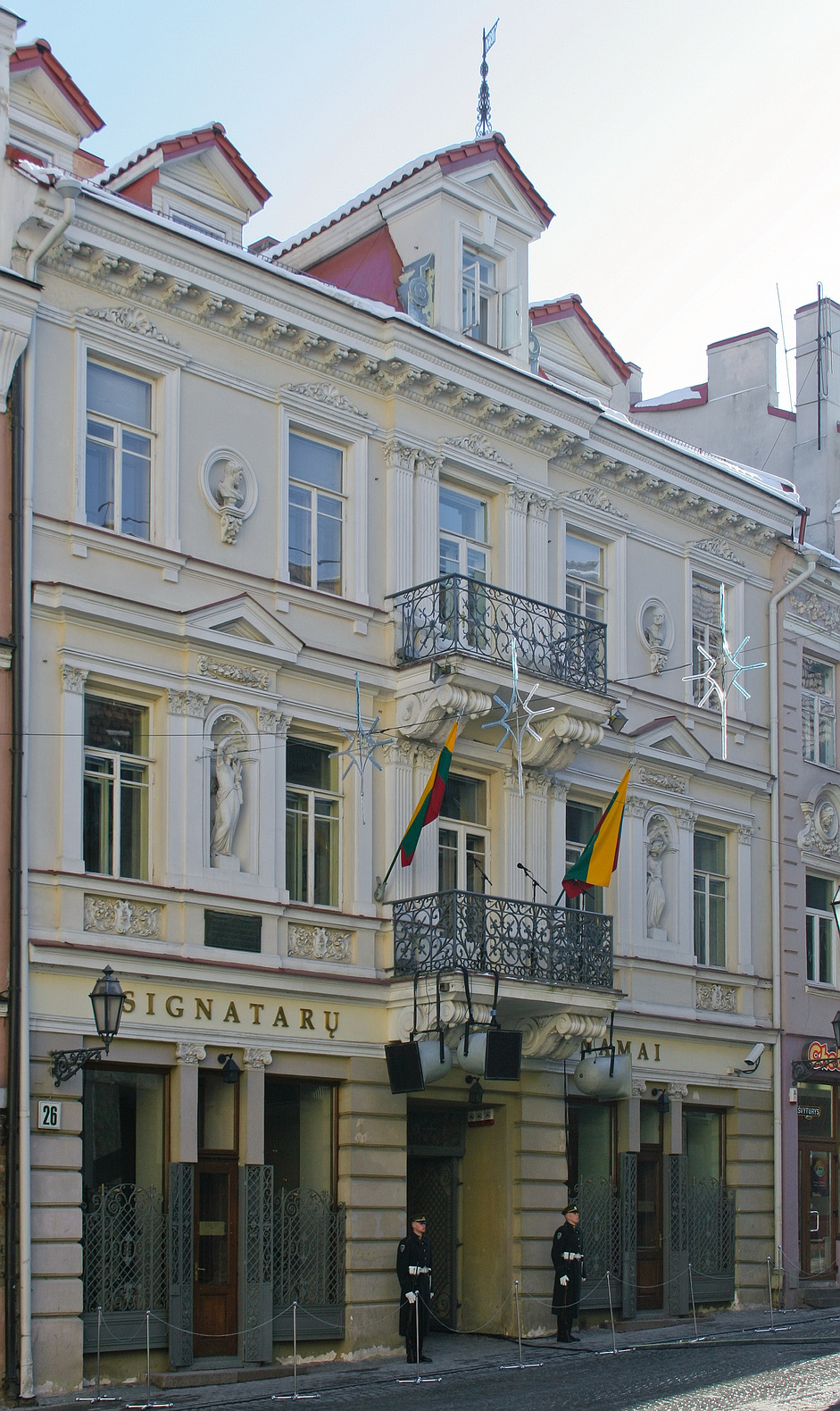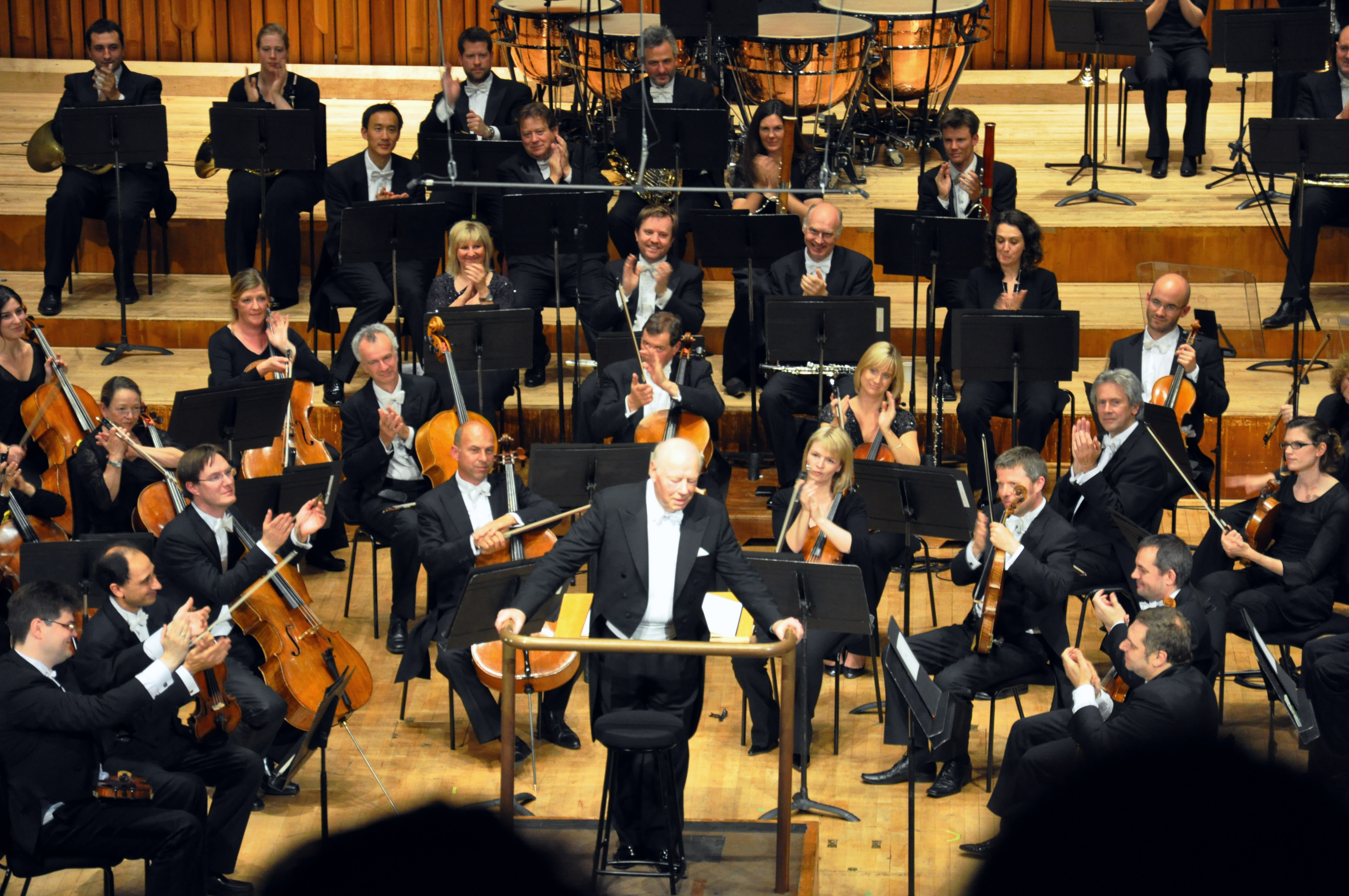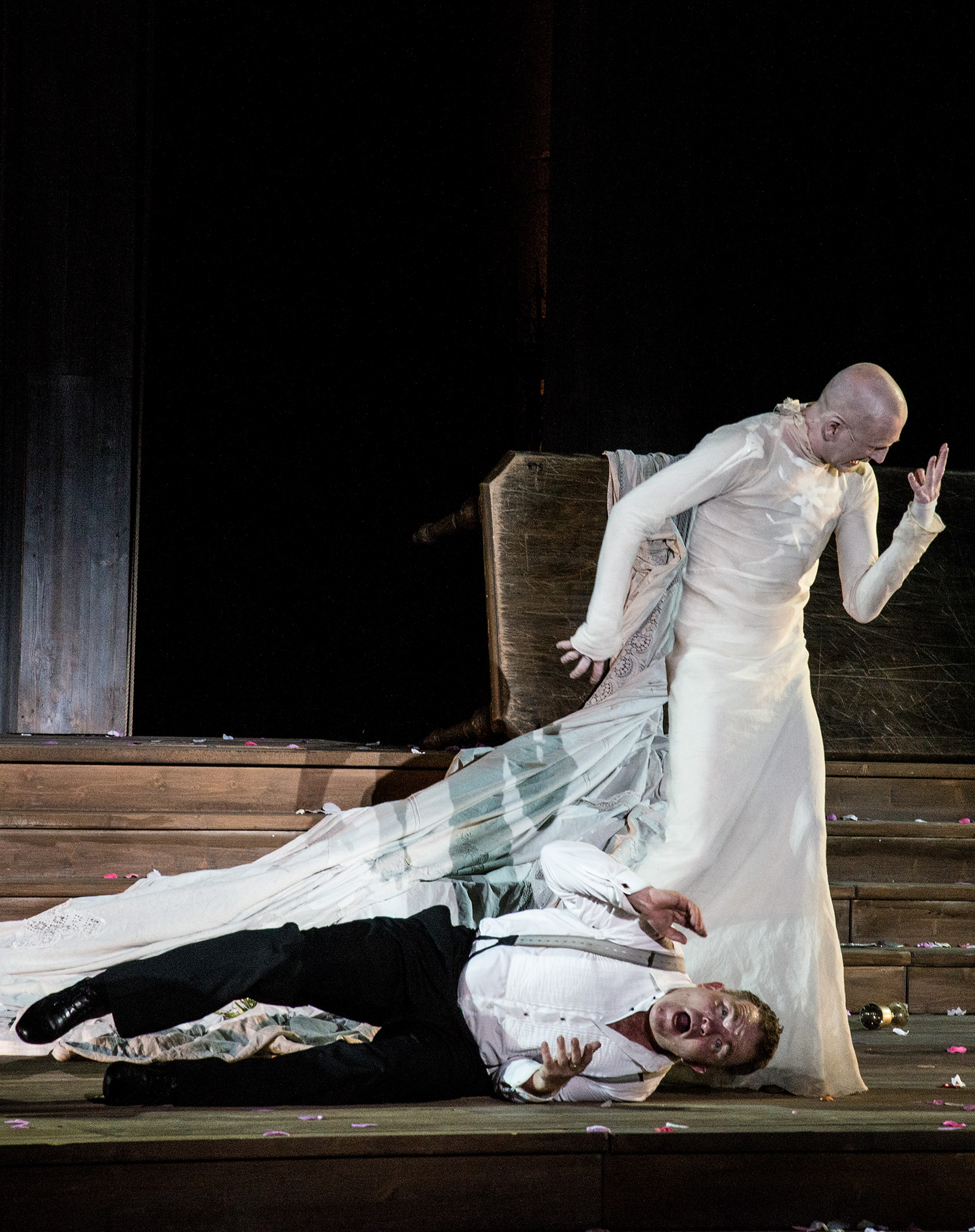|
Concerto Grosso No. 1 (Schnittke)
The Concerto Grosso No. 1 was the first of six concerti grossi by Soviet composer Alfred Schnittke. It was written in 1976–1977 at the request of Gidon Kremer and Tatiana Grindenko who were also the violin soloists at its premiere on 21 March 1977 in Leningrad together with Yuri Smirnov on keyboard instruments and the Leningrad Chamber Orchestra under Eri Klas. It is one of the best-known of Schnittke's polystylistic compositions and marked his break-through in the West. History In May 1976, Gidon Kremer and Tatiana Grindenko asked Schnittke to compose a work for them and the Lithuanian Chamber Orchestra under the conductor Saulius Sondeckis to be performed several times in 1977 and recorded. It was Kremer who came up with the idea of a ''concerto grosso''. The score was ready by the end of 1976, and the piece was premiered on 21 March 1977 under the baton of Estonian conductor Eri Klas, a mutual friend of both Kremer and Schnittke, together with the Leningrad Chamber Orches ... [...More Info...] [...Related Items...] OR: [Wikipedia] [Google] [Baidu] |
Alfred Schnittke
Alfred Garrievich Schnittke (russian: Альфре́д Га́рриевич Шни́тке, link=no, Alfred Garriyevich Shnitke; 24 November 1934 – 3 August 1998) was a Russian composer of Jewish-German descent. Among the most performed and recorded composers of late 20th-century classical music, he is described by musicologist Ivan Moody as a "composer who was concerned in his music to depict the moral and spiritual struggles of contemporary man in ..depth and detail." Schnittke's early music shows the strong influence of Dmitri Shostakovich. He developed a polystylistic technique in works such as the epic Symphony No. 1 (1969–1972) and his first concerto grosso (1977). In the 1980s, Schnittke's music began to become more widely known abroad with the publication of his second (1980) and third (1983) string quartets and the String Trio (1985); the ballet ''Peer Gynt'' (1985–1987); the third (1981), fourth (1984), and fifth (1988) symphonies; and the viola concerto (19 ... [...More Info...] [...Related Items...] OR: [Wikipedia] [Google] [Baidu] |
Vilnius
Vilnius ( , ; see also other names) is the capital and largest city of Lithuania, with a population of 592,389 (according to the state register) or 625,107 (according to the municipality of Vilnius). The population of Vilnius's functional urban area, which stretches beyond the city limits, is estimated at 718,507 (as of 2020), while according to the Vilnius territorial health insurance fund, there were 753,875 permanent inhabitants as of November 2022 in Vilnius city and Vilnius district municipalities combined. Vilnius is situated in southeastern Lithuania and is the second-largest city in the Baltic states, but according to the Bank of Latvia is expected to become the largest before 2025. It is the seat of Lithuania's national government and the Vilnius District Municipality. Vilnius is known for the architecture in its Old Town, declared a UNESCO World Heritage Site in 1994. The city was noted for its multicultural population already in the time of the Polish–Li ... [...More Info...] [...Related Items...] OR: [Wikipedia] [Google] [Baidu] |
Jean Sibelius
Jean Sibelius ( ; ; born Johan Julius Christian Sibelius; 8 December 186520 September 1957) was a Finnish composer of the late Romantic and early-modern periods. He is widely regarded as his country's greatest composer, and his music is often credited with having helped Finland develop a national identity during its struggle for independence from Russia. The core of his oeuvre is his set of seven symphonies, which, like his other major works, are regularly performed and recorded in Finland and countries around the world. His other best-known compositions are '' Finlandia'', the '' Karelia Suite'', '' Valse triste'', the Violin Concerto, the choral symphony '' Kullervo'', and '' The Swan of Tuonela'' (from the '' Lemminkäinen Suite''). His other works include pieces inspired by nature, Nordic mythology, and the Finnish national epic, the '' Kalevala;'' over a hundred songs for voice and piano; incidental music for numerous plays; the one-act opera '' The Maiden in the Towe ... [...More Info...] [...Related Items...] OR: [Wikipedia] [Google] [Baidu] |
LP Album
The LP (from "long playing" or "long play") is an analog sound storage medium, a phonograph record format characterized by: a speed of rpm; a 12- or 10-inch (30- or 25-cm) diameter; use of the "microgroove" groove specification; and a vinyl (a copolymer of vinyl chloride acetate) composition disk. Introduced by Columbia in 1948, it was soon adopted as a new standard by the entire record industry. Apart from a few relatively minor refinements and the important later addition of stereophonic sound, it remained the standard format for record albums (during a period in popular music known as the album era) until its gradual replacement from the 1980s to the early 2000s, first by cassettes, then by compact discs, and finally by digital music distribution. Beginning in the late 2000s, the LP has experienced a resurgence in popularity. Format advantages At the time the LP was introduced, nearly all phonograph records for home use were made of an abrasive shellac compoun ... [...More Info...] [...Related Items...] OR: [Wikipedia] [Google] [Baidu] |
Gennady Rozhdestvensky
Gennady Nikolayevich Rozhdestvensky, CBE (russian: Генна́дий Никола́евич Рожде́ственский; 4 May 1931 – 16 June 2018) was a Soviet and Russian conductor. Biography Gennady Rozhdestvensky was born in Moscow. His parents were the noted conductor and pedagogue Nikolai Anosov and soprano Natalya Rozhdestvenskaya. His given name was Gennady Nikolayevich Anosov, but he adopted his mother's maiden name in its masculine form for his professional career so as to avoid the appearance of nepotism. His younger brother, the painter P.N. Anosov, retained their father's name.Yampol'sky, I.M., ed. Stanley Sadie, "Rozhdestvensky, Gennady (Nikolayevich)", ''The New Grove Dictionary of Music and Musicians, First Edition'' (London: Macmillan, 1980), 20 vols. He studied conducting with his father at the Moscow Conservatory and piano with Lev Oborin. Already known for having conducted Tchaikovsky's '' The Nutcracker'' ballet at the Bolshoi Theatre at the age ... [...More Info...] [...Related Items...] OR: [Wikipedia] [Google] [Baidu] |
London Symphony Orchestra
The London Symphony Orchestra (LSO) is a British symphony orchestra based in London. Founded in 1904, the LSO is the oldest of London's orchestras, symphony orchestras. The LSO was created by a group of players who left Henry Wood's Queen's Hall Orchestra because of a new rule requiring players to give the orchestra their exclusive services. The LSO itself later introduced a similar rule for its members. From the outset the LSO was organised on co-operative lines, with all players sharing the profits at the end of each season. This practice continued for the orchestra's first four decades. The LSO underwent periods of eclipse in the 1930s and 1950s when it was regarded as inferior in quality to new London orchestras, to which it lost players and bookings: the BBC Symphony Orchestra and the London Philharmonic Orchestra in the 1930s and the Philharmonia Orchestra, Philharmonia and Royal Philharmonic Orchestra, Royal Philharmonic after the Second World War. The profit-sharing ... [...More Info...] [...Related Items...] OR: [Wikipedia] [Google] [Baidu] |
Eurodisc
Ariola (also known as Ariola Records, Ariola-Eurodisc and BMG Ariola) is a German record label. In the late 1980s, it was a subsidiary label of the Bertelsmann Music Group, which in turn has become a part of the international media conglomerate Sony Music Entertainment. Profile Ariola Eurodisc GmbH was founded in 1958 as a music outlet of Bertelsmann. It set up several foreign subsidiaries. Ariola America was founded in 1975 in Los Angeles, and achieved ''Billboard'' magazine number one singles with Mary MacGregor's "Torn Between Two Lovers" (1976) and Amii Stewart's cover version of the 1966 Eddie Floyd hit " Knock on Wood" (1979). Other artists on the Ariola America roster during the late 1970s included Gene Cotton, The Three Degrees, Chanson, and the Canadian band Prism among others. After its pop success dried up, Ariola America found success in the Spanish language market including José José and Rocío Dúrcal from the late 1970s onward and Mexican artist Marisela sta ... [...More Info...] [...Related Items...] OR: [Wikipedia] [Google] [Baidu] |
Salzburg Festival
The Salzburg Festival (german: Salzburger Festspiele) is a prominent festival of music and drama established in 1920. It is held each summer (for five weeks starting in late July) in the Austrian town of Salzburg, the birthplace of Wolfgang Amadeus Mozart. One highlight is the annual performance of the play '' Jedermann'' (''Everyman'') by Hugo von Hofmannsthal. Since 1967, an annual Salzburg Easter Festival has also been held, organized by a separate organization. History Music festivals had been held in Salzburg at irregular intervals since 1877 held by the International Mozarteum Foundation but were discontinued in 1910. Although a festival was planned for 1914, it was cancelled at the outbreak of World War I. In 1917, Friedrich Gehmacher and Heinrich Damisch formed an organization known as the ''Salzburger Festspielhaus-Gemeinde'' to establish an annual festival of drama and music, emphasizing especially the works of Mozart. At the close of the war in 1918, the festival' ... [...More Info...] [...Related Items...] OR: [Wikipedia] [Google] [Baidu] |
Germany
Germany, officially the Federal Republic of Germany (FRG),, is a country in Central Europe. It is the most populous member state of the European Union. Germany lies between the Baltic and North Sea to the north and the Alps to the south. Its 16 constituent states have a total population of over 84 million in an area of . It borders Denmark to the north, Poland and Czechia to the east, Austria and Switzerland to the south, and France, Luxembourg, Belgium, and the Netherlands to the west. The nation's capital and most populous city is Berlin and its main financial centre is Frankfurt; the largest urban area is the Ruhr. Settlement in what is now Germany began in the Lower Paleolithic, with various tribes inhabiting it from the Neolithic onward, chiefly the Celts. Various Germanic tribes have inhabited the northern parts of modern Germany since classical antiquity. A region named Germania was documented before AD 100. In 962, the Kingdom of Germany formed the ... [...More Info...] [...Related Items...] OR: [Wikipedia] [Google] [Baidu] |
Austria
Austria, , bar, Östareich officially the Republic of Austria, is a country in the southern part of Central Europe, lying in the Eastern Alps. It is a federation of nine states, one of which is the capital, Vienna, the most populous city and state. A landlocked country, Austria is bordered by Germany to the northwest, the Czech Republic to the north, Slovakia to the northeast, Hungary to the east, Slovenia and Italy to the south, and Switzerland and Liechtenstein to the west. The country occupies an area of and has a population of 9 million. Austria emerged from the remnants of the Eastern and Hungarian March at the end of the first millennium. Originally a margraviate of Bavaria, it developed into a duchy of the Holy Roman Empire in 1156 and was later made an archduchy in 1453. In the 16th century, Vienna began serving as the empire's administrative capital and Austria thus became the heartland of the Habsburg monarchy. After the dissolution of th ... [...More Info...] [...Related Items...] OR: [Wikipedia] [Google] [Baidu] |
Eastern Bloc
The Eastern Bloc, also known as the Communist Bloc and the Soviet Bloc, was the group of socialist states of Central and Eastern Europe, East Asia, Southeast Asia, Africa, and Latin America under the influence of the Soviet Union that existed during the Cold War (1947–1991). These states followed the ideology of Marxism–Leninism, in opposition to the capitalist Western Bloc. The Eastern Bloc was often called the Second World, whereas the term " First World" referred to the Western Bloc and "Third World" referred to the non-aligned countries that were mainly in Africa, Asia, and Latin America but notably also included former pre-1948 Soviet ally SFR Yugoslavia, which was located in Europe. In Western Europe, the term Eastern Bloc generally referred to the USSR and Central and Eastern European countries in the Comecon (East Germany, Poland, Czechoslovakia, Hungary, Romania, Bulgaria, and Albania). In Asia, the Soviet Bloc comprised Mongolia, Vietnam, Laos, Kampuchea, ... [...More Info...] [...Related Items...] OR: [Wikipedia] [Google] [Baidu] |
Budapest
Budapest (, ; ) is the capital and most populous city of Hungary. It is the ninth-largest city in the European Union by population within city limits and the second-largest city on the Danube river; the city has an estimated population of 1,752,286 over a land area of about . Budapest, which is both a city and county, forms the centre of the Budapest metropolitan area, which has an area of and a population of 3,303,786; it is a primate city, constituting 33% of the population of Hungary. The history of Budapest began when an early Celtic settlement transformed into the Roman town of Aquincum, the capital of Lower Pannonia. The Hungarians arrived in the territory in the late 9th century, but the area was pillaged by the Mongols in 1241–42. Re-established Buda became one of the centres of Renaissance humanist culture by the 15th century. The Battle of Mohács, in 1526, was followed by nearly 150 years of Ottoman rule. After the reconquest of Buda in 1686, the ... [...More Info...] [...Related Items...] OR: [Wikipedia] [Google] [Baidu] |





